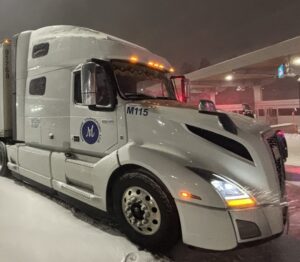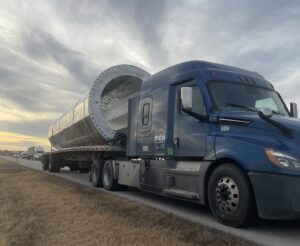WASHINGTON — The U.S. Environmental Protection Agency (EPA) has finalized its new national clean air standards to cut smog-and soot-forming emissions from heavy-duty trucks beginning with model year 2027 as part of the Clean Trucks Plan.
The new standards, which represent the first update to clean air standards for heavy duty trucks in more than 20 years, are more than 80% stronger than current standards, according to the EPA.
Reaction to the new standards came swiftly from the trucking industry this week after the EPA’s announcement on Tuesday, Dec. 20.
“TCA, alongside numerous trucking groups, have cautioned the EPA against enacting this rule because it outpaces available technology and would worsen an already-tight equipment market,” Truckload Carriers Association President Jim Ward said.
Ward said that TCA is concerned the new emissions standards for heavy-duty trucks will limit equipment options for carriers, as well as worsen environmental outcomes in the long run by raising prices and, in effect, disincentivizing fleet turnover — which is the key to reducing emissions in trucking.
“TCA maintains that a more comprehensive strategy is needed to guide fleet advancements, that realistically accounts for ongoing equipment shortages and price increases, and encourages solution-maximizing technology, without restricting equipment options prematurely,” Ward said.
American Trucking Associations (ATA) President and CEO Chris Spear said the ATA is currently reviewing details of the new standards and assessing their impact on members.
“While truck engine emission standards are directed at manufacturers, it is the purchasing decisions of fleets that ultimately determine their success or failure,” Spear said. “ATA remains extremely concerned over the potential growth of state patchworks of NOx emission standards that will create havoc for an industry that operates across local, state, and international boundaries. We hope EPA and the California Air Resources Board will ultimately agree to a uniform, single standard that best achieves our nation’s environmental goals.”
Spear added that the trucking industry has cut NOx emissions by more than 98% since 1998. He said continued progress will depend on standards that are technologically feasible with equipment that is cost-permitting and reliable for fleets.
Aside from fleets, there’s concern that owner-operators will be hit hard while they’re already facing potential changes in labor laws that would affect their work status.
“If small business truckers can’t afford the new, compliant trucks, they’re going to stay with older, less efficient trucks, or leave the industry entirely,” according to a statement from the Owner-Operator Independent Drivers Association (OOIDA).
OOIDA President Todd Spencer said that “once again, EPA has largely ignored the warnings and concerns raised by truckers in this latest rule.”
This final rulemaking is the latest step toward implementing the Clean Truck Plan, which the EPA describes as “moving America’s highly polluting heavy-duty trucking fleet towards low-carbon and electric technologies.”
Investments from the Inflation Reduction Act and Bipartisan Infrastructure Law are expected to accelerate innovation in zero-emissions truck technology, expanding access to clean school and transit buses, and training workers to install and maintain charging infrastructure.
“EPA is taking significant action to protect public health, especially the health of 72 million people living near truck freight routes in America, including our most vulnerable populations in historically overburdened communities,” EPA Administrator Michael S. Regan said. “But we’re not stopping there. This is just the first action under EPA’s Clean Trucks Plan to pave the way toward a zero-emission future. These rigorous standards, coupled with historic investments from the Inflation Reduction Act and the Bipartisan Infrastructure Law, will accelerate President Biden’s ambitious agenda to overhaul the nation’s trucking fleet, deliver cleaner air, and protect people and the planet.”
The final standards will attempt to reduce deadly smog and soot from new heavy-duty trucks starting with model year 2027. The EPA estimates that by 2045, the rule will result in the following annual public health benefits:
- Up to 2,900 fewer premature deaths.
- 6,700 fewer hospital admissions and emergency department visits.
- 18,000 fewer cases of childhood asthma.
- 3.1 million fewer cases of asthma symptoms and allergic rhinitis symptoms.
- 78,000 fewer lost days of work.
- 1.1 million fewer lost school days for children.
- $29 billion in annual net benefits.
The new standards require heavy-duty commercial vehicles to limit nitrous oxide (NOx) emissions to 0.035 grams per horsepower-hour during normal operation, 0.050 grams at low load and 10.0 grams at idle.
According to the latest regulations, warranties are extended to 450,000 miles from 100,000 and useful life to 650,000 miles from 435,000 miles, according to a statement from Eaton, a power management company.
“We applaud the EPA’s work in establishing new standards for harmful truck emissions,” Eaton Vehicle Group President João Faria said. “The final rule announced today provides the regulatory certainty needed to deploy the next generation of fuel-efficient and emission-reduction technologies. Eaton stands ready to provide cost-effective advanced powertrain technologies that make vehicles more efficient while simultaneously reducing emissions and achieving significant operational savings for our customers’ commercial vehicle fleets.”
Relative to current rules, the new standards are more than 80% stronger, and expected to increase the useful life of governed vehicles by 1.5–2.5 times, as well as yield emissions warranties that are 2.8–4.5 times longer. This final rule includes provisions for longer useful life and warranty periods.
These provisions guarantee that as target vehicles age, they will continue to meet EPA’s more stringent emissions standards for a longer period. The rule also requires manufacturers to better ensure that vehicle engines and emission control systems work properly on the road. For example, manufacturers must demonstrate that engines are designed to prevent vehicle drivers from tampering with emission controls by limiting tamper-prone access to electronic pollution controls.
“Today’s final rule establishes the next chapter for advanced diesel engines; one that is even nearer to zero emissions and more durable than ever before,” Diesel Technology Forum Executive Director Allen Schaeffer said. “DTF members are the leaders in design and manufacture of engines, emissions controls, and key components that will deliver the benefits to communities and truckers this rule envisions. The rule establishes many new challenges for manufacturers and suppliers but also ensures diesel’s place in the future for trucking. “
Schaeffer said the current generation new diesel trucks are more fuel-efficient and emit less than 1/60th the emissions of 2000 models.
“The further improvements in diesel engines anticipated in the outcome of this final rule and the ability of truckers to invest in new trucks will be fundamental to ensuring progress toward meeting both local clean air and national climate goals,” Schaeffer said. “Without continued turnover in the fleet, older generations of technology with relatively higher emissions will stay in service longer, thereby delaying benefits to disadvantaged communities and contributing to worse air quality all around the country.”
That turnover is a spot of concern, particularly when it comes to the cost of implementing the EPA’s goals.
“While we are still in the process of reviewing the details of the newly published NOX emissions rule, it is clear the rule is very stringent and will be challenging to implement,” The Truck and Engine Manufacturers Association President Jed R. Mandel said. “Our members are fully committed to working with the EPA and other stakeholders for its successful implementation. Ultimately, the success or failure of this rule hinges on the willingness and ability of trucking fleets to invest in purchasing the new technology to replace their older, higher-emitting vehicles.”
TCA’s Ward said that the trucking industry is proud of the progress it’s made over the years to protect the environment, noting that trucks today emit 60 times less than in 1988 and that engines have cut NOx and particulate matter by more than 98%.
“We are committed to continuing to innovate in this space and our association is working with fellow stakeholders to advance climate-positive outcomes, in a forward-thinking, but practical manner, that thoroughly considers present challenges,” he concluded.
The Trucker News Staff produces engaging content for not only TheTrucker.com, but also The Trucker Newspaper, which has been serving the trucking industry for more than 30 years. With a focus on drivers, the Trucker News Staff aims to provide relevant, objective content pertaining to the trucking segment of the transportation industry. The Trucker News Staff is based in Little Rock, Arkansas.
















CONGRESS PASSES LAW EPA HAS OVERSTEPPED THERE BOUNDS
ALL EPA REGS ARE UNCONSTITUTIONAL!!!!!